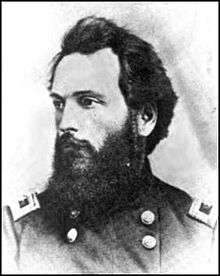Charles Edward Hovey
| Charles Edward Hovey | |
|---|---|
 Charles Edward Hovey | |
| Born |
April 26, 1827 Thetford, Vermont, U.S. |
| Died |
November 17, 1897 (aged 70) Washington, D.C. |
| Place of burial | Arlington National Cemetery |
| Allegiance |
United States of America Union |
| Service/branch |
United States Army Union Army |
| Rank |
|
| Battles/wars | American Civil War |
Charles Edward Hovey (April 26, 1827 – November 17, 1897) was an educator, college president, pension lobbyist and a brevet major general in the United States Army during the American Civil War.
Biography
Hovey was born in Thetford, Vermont. He graduated from Dartmouth in 1852, spending his summer vacations teaching school to help pay for his education. He briefly studied law and taught school in Framingham, Massachusetts, before moving to Illinois, where he served as principal and then superintendent of schools in Peoria. He became President of the State Teacher's Association and a member of the first Illinois State Board of Education. He assisted in the organization of Illinois State University, teaching the first classes and serving as president from 1857 to 1861. He was married to Harriette Farnham (Spofford) Hovey of Nantucket, Massachusetts. Their son Richard Hovey became a well-known poet, artist, and college professor. A distant cousin, Alvin Peterson Hovey, also served as a Civil War general.
When the Civil War erupted in 1861, Hovey resigned from the university at the end of the school year and raised the 33rd Illinois Infantry, a regiment organized in McLean County and largely comprising teachers and former students from his school. Hovey insisted that the students graduate before enlisting. He was commissioned colonel on August 15, 1861, and took the regiment to Missouri, where it saw service in a number of small actions during the winter. At the Battle of Cotton Plant in July 1862, Hovey's badly outnumbered Illinois and Wisconsin infantry repeatedly repulsed a series of poorly organized attacks by Confederate Col. William H. Parsons's two Texas cavalry regiments.
Hovey was appointed a Brigadier General of Volunteers to rank from September 5, 1862; however, the U.S. Senate did not to act upon his nomination within the statuary period, and it expired by law March 4, 1863. In the interim, he played a key role in the capture of Arkansas Post in January 1863, where William T. Sherman reported that Hovey had been "wounded in his arm by a shell, but continued and still continues to command his Brigade." Suffering lingering effects from his injury, Hovey soon left the field service. With the close of the war, he was given a brevet promotion to major general "for gallant and meritorious conduct in battle, particularly at Arkansas Post, January 11, 1863."
After the war, Hovey and his wife lived in Washington, D.C. Having once briefly studied law, he became a successful pension lobbyist and practicing attorney. He died in Washington D.C. and was buried with full military honors in Arlington National Cemetery.
A building at Illinois State University was renamed "Hovey Hall" in 1959 in honor of Charles E. Hovey. It houses administrative offices, including the Office of the President.
See also
References
- Warner, Ezra J., Generals in Blue: Lives of the Union Commanders, Louisiana State University Press, 1964, ISBN 0-8071-0822-7.
- Arlington National Cemetery biography
- Illinois Regiments in the Civil War: webpage for the 33rd Illinois
External links
- "Charles Edward Hovey". Find a Grave. Retrieved 2008-08-04.
- 1882 ISU History
- Grandest of Enterprises
- The Triumvirs of Four-and-a-half Street, by Hovey